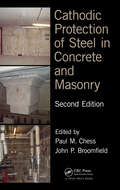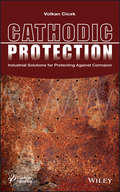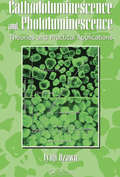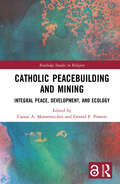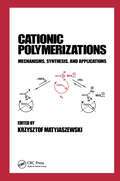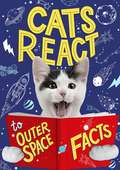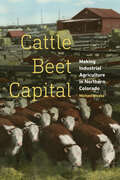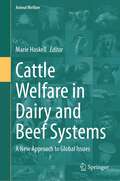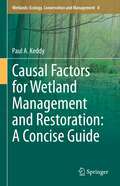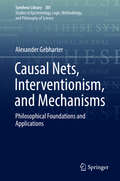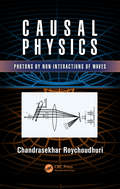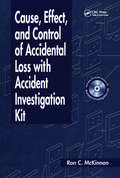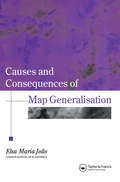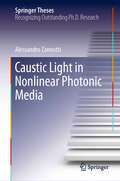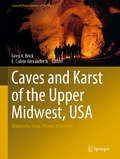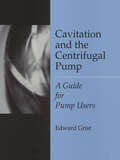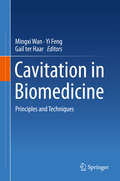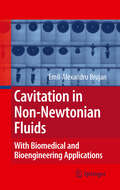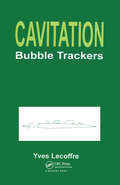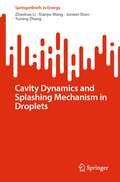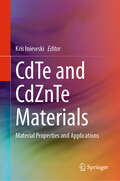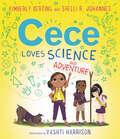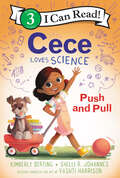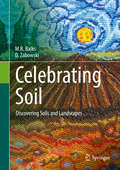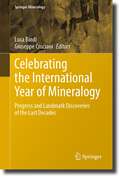- Table View
- List View
Cathodic Protection of Steel in Concrete and Masonry
by Paul M. Chess John P. BroomfieldRevised and updated, this second edition of Cathodic Protection of Steel in Concrete and Masonry covers both reinforced concrete and masonry structures, describes in detail the overall design factors involved in cathodic protection (CP), and also provides a theoretical basis for why it works. It refers to the new European standard EN 12696 for cath
Cathodic Protection: Industrial Solutions for Protecting Against Corrosion
by Volkan CicekA companion to the title Corrosion Chemistry, this volume covers both the theoretical aspects of cathodic protection and the practical applications of the technology, including the most cutting-edge processes and theories. Engineers and scientists across a wide range of disciplines and industries will find this the most up-to-date, comprehensive treatment of cathodic protection available. A superb reference and refresher on the chemistry and uses of the technology for engineers in the field, the book also provides a tremendous introduction to the science for newcomers to the field.
Cathodoluminescence and Photoluminescence: Theories and Practical Applications
by Lyuji OzawaWritten by a senior industry expert with nearly 40 years of hands-on experience, Cathodoluminescence and Photoluminescence: Theories and Practical Applications presents a thorough review of advances, challenges, and recommendations for improving photoluminescent (PL) and cathodoluminescent (CL) phosphor display devices in terms of energy efficiency, image quality, color fidelity, operational lifetime, and production cost.This book traces the development of cathode ray tubes (CRTs), PL and CL phosphor screens, and fluorescent lamps (FL) into modern phosphor display devices. The author relates luminescence phenomena and color to chemical composition, excitation mechanisms, energy conversion efficiencies, and bulk properties of phosphor particles. He also addresses image quality issues such as flickering, smearing, whitening, and contrast. Subsequent chapters focus on powder deposition techniques and the production of phosphor powders themselves. The text describes the necessary raw materials, flux materials, and growth conditions for producing ZnS powders. It provides a quantitative analysis on optimal processes and parameters for ensuring higher quality color and screen resolution. Offering a detailed guide for next-generation scientists and engineers in the field, Cathodoluminescence and Photoluminescence describes current technologies and promising developments for producing higher quality, energy-efficient, and long-lasting phosphor CR and flat CL screen displays.
Catholic Peacebuilding and Mining: Integral Peace, Development, and Ecology (Routledge Studies in Religion)
by Caesar A. MontevecchioThis book explores the role of Catholic peacebuilding in addressing the global mining industry. Mining is intimately linked to issues of conflict, human rights, sustainable development, governance, and environmental justice. As an institution of significant scope and scale with a large network of actors at all levels and substantial theoretical and ethical resources, the Catholic Church is well positioned to acknowledge the essential role of mining, while challenging unethical and harmful practices, and promoting integral peace, development, and ecology. Drawing together theology, ethics, and praxis, the volume reflects the diversity of Catholic action on mining and the importance of an integrated approach. It includes contributions by an international and interdisciplinary range of scholars and practitioners. They examine Catholic action on mining in El Salvador, Peru, Colombia, the Democratic Republic of the Congo, and the Philippines. They also address general issues of corporate social responsibility, human rights, development, ecology, and peacebuilding. The book will be of interest to scholars of theology, social ethics, and Catholic studies as well as those specializing in development, ecology, human rights, and peace studies.
Cationic Polymerizations: Mechanisms, Synthesis & Applications (Plastics Engineering)
by Krzysztof MatyjaszewskiThis unified presentation of cationic polymerization discusses initiation, propagation, transfer, and termination in cationic polymerizations of alkenes and heterocycles. It also elucidates the mechanisms of the reactions involved in all carbocationic and ring-opening polymerizations. It is written by internationally acclaimed experts in their resp
Cats React to Outer Space Facts
by Izzi HowellCats React is back for a second instalment! Share in the wonderment of space with a crew of crazy cats and measure your amazement, awe and disgust alongside their furry feline faces!Like every topic, space becomes more interesting when cats are involved. Cats React to Space Facts is an engaging and fun way to understand our universe. It's just purrfect! Bitesize text, fun photos, diagrams, dollops of humour and a react-o-meter all help to make science memorable and fun to learn.This book is a great gift for cat lovers and science students aged 7 and beyond, covering physics in a unique way.
Cattle Beet Capital: Making Industrial Agriculture in Northern Colorado
by Michael WeeksIn 1870 several hundred settlers arrived at a patch of land at the confluence of the South Platte and Cache la Poudre Rivers in Colorado Territory. Their planned agricultural community, which they named Greeley, was centered around small landholdings, shared irrigation, and a variety of market crops. One hundred years later, Greeley was the home of the world&’s largest concentrated cattle-feeding operation, with the resources of an entire region directed toward manufacturing beef. How did that transformation happen? Cattle Beet Capital is animated by that question. Expanding outward from Greeley to all of northern Colorado, Cattle Beet Capital shows how the beet sugar industry came to dominate the region in the early twentieth century through a reciprocal relationship with its growers that supported a healthy and sustainable agriculture while simultaneously exploiting tens of thousands of migrant laborers. Michael Weeks shows how the state provided much of the scaffolding for the industry in the form of tariffs and research that synchronized with the agendas of industry and large farmers. The transformations that led to commercial feedlots began during the 1930s as farmers replaced crop rotations and seasonal livestock operations with densely packed cattle pens, mono-cropped corn, and the products pouring out of agro-industrial labs and factories. Using the lens of the northern Colorado region, Cattle Beet Capital illuminates the historical processes that made our modern food systems.
Cattle Welfare in Dairy and Beef Systems: A New Approach to Global Issues (Animal Welfare #23)
by Marie HaskellThis book provides a comprehensive coverage of all aspects of the welfare of cattle. It starts with a consideration of animal welfare science and its application to the management of cattle and moves through to discussions of the challenges and opportunities for providing good welfare for cattle in farming and husbandry systems across the globe. The first section comprises three chapters that discuss the social, behavioural and physiological methods that can be used to assess welfare in cattle. The second section considers the welfare challenges of beef and dairy cattle in extensive and intensive systems. The third section details welfare challenges such as at slaughter, during handling and in the growing period and details solutions such as the use of sensors and application of animal breeding techniques. The final section addresses welfare challenges and solutions in achieving sustainability, in smallholder farms in Africa and new entrant dairying in Asia and cow shelters in India. This work makes a valuable contribution to the field of animal welfare and modern livestock farming. It is a must-read for researchers and students, veterinarians as well as industry personnel and informed farmers and producers.
Causal Factors for Wetland Management and Restoration: A Concise Guide (Wetlands: Ecology, Conservation and Management #8)
by Paul A. KeddyThis book presents 12 effective methods to manage wetlands for conservation. It offers a tool box of causal factors that can be used to protect and restore wetlands to enhance biological diversity and other functions. Each causal factor is introduced, briefly explained, and then illuminated with selected examples from around the world.The book provides a prioritized shopping list of methods for protecting and restoring wetlands. The three first and most important causal factors are flooding, fertility, and natural disturbance. Then nine other causal factors are introduced, including herbivory, sedimentation, roads, invasive species, and coarse woody debris. Each causal factor is carefully linked to the scientific literature and explained using the author’s own experience. The same list of 12 causal factors applies around the world—whether you are managing a temperate zone floodplain, a tropical peatland, a freshwater marsh, or a coastal mangrove swamp. Instead of hiring an expensive team of consultants, or pouring through hundreds of scientific papers, here is one concise guide to methods that can be immediately applied to benefit any wetland.Professor Paul Keddy has spent more than 50 years studying wetlands, and writing and lecturing about the environmental factors that control them. He has published more than 150 scholarly papers, and won multiple scientific prizes. His book Wetland Ecology is widely used to teach the principles of wetland science. Causal Factors for Wetland Management: A Concise Guide has a much simpler message: how to protect and enhance wetlands. In this concise guide, he has condensed a lifetime of experience into just 12 principles. The book is aimed at all people who protect or restore wetlands: park managers, wildlife biologists, landscape architects, engineers, environmental consultants, environmental agencies, conservation authorities, and NGOs—as well as landowners and concerned citizens. Causal Factors for Wetland Management: A Concise Guide is essential reading for anyone who cares for wetlands and wild places.
Causal Nets, Interventionism, and Mechanisms: Philosophical Foundations and Applications (Synthese Library #381)
by Alexander GebharterThis monograph looks at causal nets from a philosophical point of view. The author shows that one can build a general philosophical theory of causation on the basis of the causal nets framework that can be fruitfully used to shed new light on philosophical issues. Coverage includes both a theoretical as well as application-oriented approach to the subject. The author first counters David Hume's challenge about whether causation is something ontologically real. The idea behind this is that good metaphysical concepts should behave analogously to good theoretical concepts in scientific theories. In the process, the author offers support for the theory of causal nets as indeed being a correct theory of causation. Next, the book offers an application-oriented approach to the subject. The author shows that causal nets can investigate philosophical issues related to causation. He does this by means of two exemplary applications. The first consists of an evaluation of Jim Woodward's interventionist theory of causation. The second offers a contribution to the new mechanist debate. Introductory chapters outline all the formal basics required. This helps make the book useful for those who are not familiar with causal nets, but interested in causation or in tools for the investigation of philosophical issues related to causation.
Causal Physics: Photons by Non-Interactions of Waves
by Chandrasekhar RoychoudhuriCausal Physics: Photons by Non Interactions of Waves redefines the mathematical Superposition Principle as an operational Superposition Effect; which is the measurable physical transformation experienced by a detector due to stimulations induced by multiple waves simultaneously acting on the detecting dipoles. This light-matter interaction process driven model emerges naturally by incorporating the observed properties, Non-Interaction of Waves (NIW) and quantized photo detectors needing to fill up their "quantum-cups" with the required quantity of energy from all the stimulating waves around it. By not incorporating this NIW-property explicitly, quantum mechanics failed to extract various embedded realities in the theory while incorporated unnecessary hypotheses like wave-particle duality. The book utilizes this NIW-property to explain all the major optical phenomena (diffraction, spectrometry, coherence.) without using any self-contradictory hypotheses that are prevalent now. The book redefines the old ether (constituting the space) as a stationary Complex Tension Field (CTF), holding all the energy of the universe (no need for Dark Energy of Dark Matter). CTF sustains perpetually propagating EM waves as its linear excitations and the particles as self-looped localized resonant non-linear excitations. Tensions are identified by Maxwell, then the velocities of emitting and detecting atoms through the CTF contribute to the Doppler shifts separately. This calls for re-visiting physical processes behind Hubble Redshift and hence Expanding Universe. The success of the book derives from a novel thinking strategy of visualizing the invisible interaction processes, named as Interaction Process Mapping Epistemology (IPM-E). This is over and above the prevailing strategy of Measurable Data Modeling Epistemology (MDM-E). The approach inspires the next generation of physicists to recognizing that the "foundation of the edifice of physics" has not yet been finalized. IPM-E will stimulate more of us to become technology innovators by learning to emulate the ontologically real physical processes in nature and become more evolution congruent. Critical thinkers without expertise in optical science and engineering, will appreciate the value of the content by reading the book backward, starting from Ch.12; which explains the critical thinking methodology besides giving a very brief summary of the contents in the previous chapters. Establishes that abandoning the wave-particle-duality actually allows us to extract more realities out of quantum mechanics. Illustrates how the discovery of the NIW-property profoundly impacts several branches of fundamental physics, including Doppler effect and hence the cosmological red shift Summarizes that many ad hoc hypotheses from physics can be removed, a la Occam’s razor, while improving the reality and comprehension of some of the current working theories Demonstrates that our persistent attempts to restore causality in physical theories will be guided by our capability to visualize the invisible light matter interaction processes that are behind the emergence of all measurable data Draws close attention to the invisible but ontological interaction processes behind various optical phenomena so we can emulate them more efficiently and knowledgably in spite of limitations of our theories Designed as a reference book for general physics and philosophy, this optical science and engineering book is an ideal resource for optical engineers, physicists, and those working with modern optical equipment and high precision instrumentation.
Cause, Effect, and Control of Accidental Loss with Accident Investigation Kit
by Ron Charles McKinnonAccident: an undesired event that results in loss. Most people give little thought to accidents or their prevention. Health and safety professionals face this challenge, and its associated costs and losses, both human and financial, every day. Cause, Effect, and Control of Accidental Loss with Accident Investigation Kit provides the tools you need
Causes And Consequences Of Map Generalization
by Elsa JoaoThis text describes late-1990s understanding of map generalisation in the context of paper maps and GIS. Its particular value should be in helping to further automate and measure the process of map generalisation.; The research has concentrated on quantifying generalisation effects and on analysing how these effects of generalisation locked into the maps were measured. Elsa Joao's book covers the background to the problems of map generlasation; the methodology developed by the author to investigate the consequences of the map generalisation; a detailed description of results, and a conclusion that draws together consequences for the broader applications to GIS.
Caustic Light in Nonlinear Photonic Media (Springer Theses)
by Alessandro ZannottiCaustics are natural phenomena, forming light patterns in rainbows or through drinking glasses, and creating light networks at the bottom of swimming pools. Only in recent years have scientists started to artificially create simple caustics with laser light. However, these realizations have already contributed to progress in advanced imaging, lithography, and micro-manipulation. In this book, Alessandro Zannotti pioneers caustics in many ways, establishing the field of artificial caustic optics. He employs caustic design to customize high-intensity laser light. This is of great relevance for laser-based machining, sensing, microscopy, and secure communication. The author also solves a long standing problem concerning the origin of rogue waves which appear naturally in the sea and can have disastrous consequences. By means of a far-reaching optical analogy, he identifies scattering of caustics in random media as the origin of rogue waves, and shows how nonlinear light-matter interaction increases their probability.
Caves and Karst of the Upper Midwest, USA: Minnesota, Iowa, Illinois, Wisconsin (Cave and Karst Systems of the World)
by Greg A. Brick E. Calvin Alexander Jr.This book discusses the karst and pseudokarst of the Upper Midwest, USA, consisting of the states of Minnesota, Wisconsin, Iowa, and Illinois—the first regional synthesis in 40 years. Starting with an overview of the regional geology of what is largely glaciated fluviokarst and paleokarst developed on Paleozoic carbonates, but including other lithologies such as the St. Peter Sandstone and the Ft. Dodge Gypsum, the caves, springs, sinkholes, and karst hydrogeology of each state are described. Special attention is devoted to the region’s longest caves: Coldwater Cave, Mystery Cave, and the Minnesota Cave Preserve caves. Application of tools such as data loggers and LiDAR, with new conceptual models such as hypogenic speleogenesis, has been transformative here. Special topics include lead and zinc mining in the Driftless Area, vertebrate and invertebrate cave fauna near the Laurentide ice limit, the impact and policies of nutrient and herbicide intensive modern agriculture on karst, and paleoclimate studies. The discovery, exploration, institutional history of caving organizations, and show caves of the Upper Midwest, from the year 1700 onwards, are brought up to date. The top 10 historical paradigms of cave and karst science in the Midwest are reviewed. Perspectives on paleontology, archeology, and Native American rock art are included.
Cavitation And The Centrifugal Pump: A Guide For Pump Users
by Edward GristThis practical reference describes the occurrence of cavitation in a centrifugal pump, and how unacceptable cavitation can be avoided. It explains cavitation problems such as hydraulic performance loss, hydrodynamically or thermodynamically induced surging, and cavitation erosion. General guidelines for acceptable operation conditions, such as, net positive suction head (NPSH) margins and minimum flowrates, are presented along with evidence and logic for these proposed guidelines.
Cavitation in Biomedicine: Principles and Techniques
by Yi Feng Mingxi Wan Gail Ter HaarThis book offers a systematic introduction to the engineering principles and techniques of cavitation in biomedicine on the basis of its physics and mechanism. Adopting an interdisciplinary approach, it covers areas of interest ranging from physics and engineering to the biological and medical sciences. Individual chapters introduce the fundamentals of cavitation, describe its characterization, control and imaging techniques, and present cavitation-enhanced thermal and mechanical effects and their applications. Intended as both a reference work for graduate students, and as a guide for scientists and engineers who work with cavitation in biomedicine, it provides a broad and solid foundation of knowledge. The aim is to bridge the different disciplines involved, and to promote cross-discipline research, thus encouraging innovations in the scientific research and engineering applications alike. Dr. Mingxi Wan is a professor at Department of Biomedical Engineering, Xi'an Jiao Tong University, Xi'an, Shaanxi, China; Dr. Yi Feng works at Department of Biomedical Engineering, Xi'an Jiao Tong University, Xi'an, Shaanxi, China; Dr. Gail ter Haar is a professor at The Institute of Cancer Research, Sutton, Surry, UK.
Cavitation in Non-Newtonian Fluids: With Biomedical and Bioengineering Applications
by Emil BrujanNon-Newtonian properties on bubble dynamics and cavitation are fundamentally different from those of Newtonian fluids. The most significant effect arises from the dramatic increase in viscosity of polymer solutions in an extensional flow, such as that generated about a spherical bubble during its growth or collapse phase. In addition, many biological fluids, such as blood, synovial fluid, and saliva, have non-Newtonian properties and can display significant viscoelastic behaviour. This monograph elucidates general aspects of bubble dynamics and cavitation in non-Newtonian fluids and applies them to the fields of biomedicine and bioengineering. In addition it presents many examples from the process industries. The field is strongly interdisciplinary and the numerous disciplines involve have and will continue to overlook and reinvent each others' work. This book helps researchers to think intuitively about the diverse physics of these systems, to attempt to bridge the various communities involved, and to convey the interest, elegance, and variety of physical phenomena that manifest themselves on the micrometer and microsecond scales.
Cavitation: Bubble Trackers
by Yves LecoffreThis text deals with the concept that cavitation is the main limitation to the performance of hydraulic components. Topics covered include the vaporization of liquids due to high velocities or pressure fluctuations, and the effects of cavitation on the performances of rotary machinery. One chapter is devoted to cavitation noise which concerns many users, including surface ships and submarines, and the author finishes with some examples of the use of cavitation and subject-specific measuring techniques.
Cavity Dynamics and Splashing Mechanism in Droplets (SpringerBriefs in Energy)
by Xiaoyu Wang Yuning Zhang Zhaohao Li Junwei ShenThis brief explores the pivotal realm of droplet cavitation, a subject of great significance for enhancing fuel atomization and improving various industrial processes. The authors employ high-speed photography experiments, analyze bubble dynamics equations, and utilize numerical simulations to explore the dynamic behavior of cavitation bubbles and droplets. The book analyzes the entire lifecycle of cavitation bubbles, their interactions with different liquid droplets, and the key parameters governing their oscillation and collapse and sheds light on the collapse mechanisms and shock wave propagation influenced by liquid droplets. Additionally, it investigates the dynamics of droplet spattering by categorizing spatter patterns under diverse conditions, discusses the critical stability of droplet surfaces, and reveals the mechanisms by which cavitation bubble collapses induce droplet breakage. Taking vapor bubbles and diesel droplets as examples, the dynamic characteristics of specific droplets containing bubbles are also analyzed. This book offers an in-depth understanding of these phenomena with practical implications for a wide range of industrial applications and is a useful tool for researchers and engineers working in the fields of fluid dynamics, combustion engineering, and atomization processes.
CdTe and CdZnTe Materials: Material Properties and Applications
by Kris IniewskiThis book provides readers with a good overview of some of most recent advances in the field of CdTe and CdZnTe detector technology for medical imaging, industrial testing and security scanning, especially as it pertains to new applications. There will be a good mixture of general chapters in both technology and applications inthe X-ray testing. The book will have an in-depth review of the research topics from leading world specialists in the field. The conversion of the X-ray and gamma-ray signal into analogue/digital value will be covered in some chapters. Some would also provide a review of CMOS chips for CdTe and CdZnTe image sensors. This book serves as an excellent reference for people already working in the field as well as for people wishing to enter it.
Cece Loves Science and Adventure (Cece Loves Science #2)
by Kimberly Derting Shelli R. Johannes“Smart girls, friendship, and fun: a winning combination.” —Kirkus“A wonderful book.” —School Library JournalCece loves science and adventure!In this STEM-themed Girls in Science picture book, Cece and her Adventure Girls troop use science, technology, engineering, and math to solve problems and earn their camping pin. Illustrated by New York Times–bestseller Vashti Harrison, Cece Loves Science and Adventure is perfect for fans of Ada Twist, Scientist and anyone who enjoys asking questions and figuring out how things work. Cece loves being an Adventure Girl almost as much as she loves science, which is why she can’t wait for her troop’s camping trip. Nature is full of science for Cece to explore!Along with her friends, her mom, and her dog, Einstein, Cece learns how to pitch a tent, set up a campsite, and document landmarks on the trail. Then thunder booms in the distance! Working together, the girls use meteorology and math to determine the location of the storm; engineering to build a shelter; and technology and math to calculate the length of the trek back to the campsite. After all that teamwork, Cece’s mom gives them an Adventure Girl surprise!Illustrated by Vashti Harrison, author and illustrator of the New York Times–bestselling Little Leaders: Bold Women in Black History, Cece Loves Science and Adventure is just right for curious kids and anyone who loves to explore the great outdoors. Includes a glossary.
Cece Loves Science: Push and Pull (I Can Read Level 3)
by Kimberly Derting Shelli R. JohannesCece loves science! In this STEM-themed Level 3 I Can Read! title, Cece and her friend Isaac learn about the opposite forces of push and pull, and use their new knowledge to create a treat dispenser for Cece’s dog, Einstein. Perfect for aspiring scientists, emerging readers, and fans of Andrea Beaty’s Ada Twist, Scientist. Cece loves science—and experimenting! In this Cece Loves Science Level 3 I Can Read!, Cece’s teacher, Miss Curie, explains the opposite forces of push and pull. To demonstrate this concept, she divides the class into two teams. Each team must make a treat dispenser for Cece’s dog, Einstein, that uses both forces. Cece and her classmates rely on science, creativity, and teamwork—and they learn a lot along the way. The Cece Loves Science books introduce readers to basic concepts of science, technology, engineering, and math, and are perfect for the classroom. This Level 3 I Can Read! focuses on basic scientific vocabulary and includes a glossary of terms and fun activities for readers to try on their own. A great pick for beginning readers!
Celebrating Soil: Discovering Soils and Landscapes
by M. R. Balks D. ZabowskiThis richly illustrated book celebrates the diversity, importance, and intrinsic beauty of soils around the world and helps the reader to understand the ways that soils are related to the landscapes in which they form. The book unravels the complex bond between humans and soils and the importance of soils in our cultures and everyday lives. Soil is critical to terrestrial life on earth. It underpins human food supply and provides materials on which we build our lives. Soil is out of sight and often out of mind, thus easy to overlook. Yet soil has tremendous variety and intrinsic beauty for those who care to look. Soil contains a memory of the events that have shaped the landscape and the environment. With help you can look at a soil and understand the stories that it has to tell. Written in a reader-friendly way, Celebrating Soil is a wonderful resource for farmers, horticulturalists, naturalists, students and others who are concerned about how soils are formed, work and are used.
Celebrating the International Year of Mineralogy: Progress and Landmark Discoveries of the Last Decades (Springer Mineralogy)
by Luca Bindi Giuseppe CrucianiThis volume celebrates mineral sciences and what are considered the most important progresses and breakthroughs in this discipline. Authoritative authors, who, in most cases, are the direct discoverers recount the steps of their research, which represent landmark developments of mineralogy and mineralogical crystallography.
